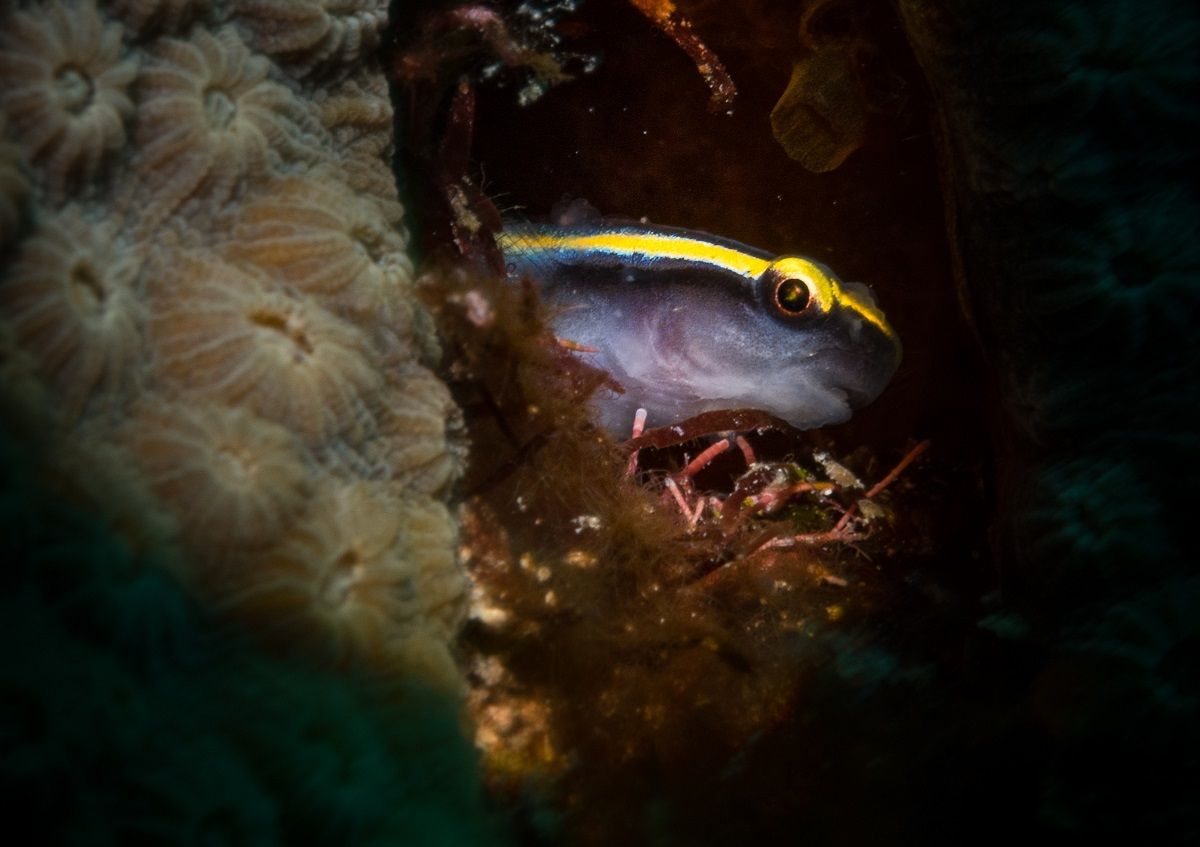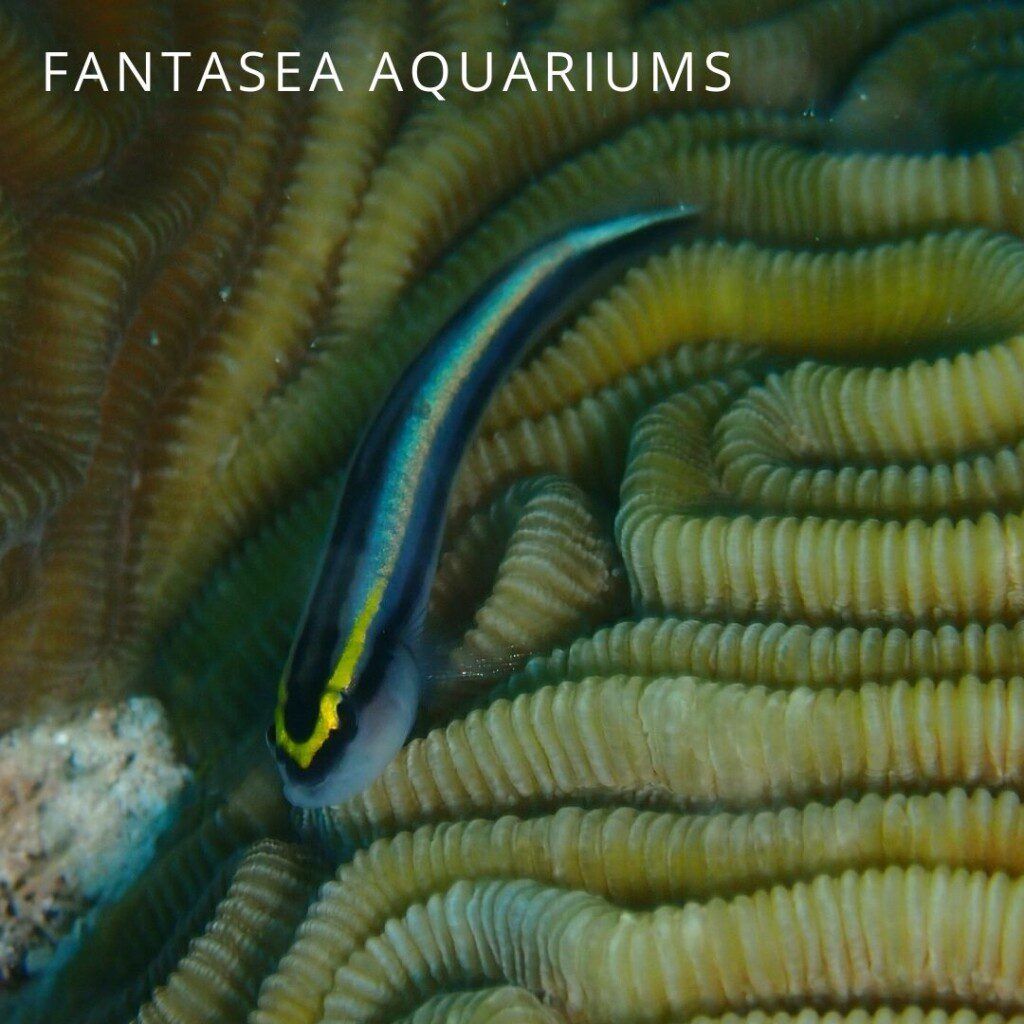Looking for a colorful addition to your reef aquarium? Sometimes, good things really do come in small packages! The Caribbean sharknose goby (Elacatinus evelynae) may be tiny, but it more than makes up for that in color and personality.
Keep reading for everything you need to know about keeping the sharknose goby in your marine aquarium!
| Name (Common, Scientific) | Sharknose goby, Caribbean cleaner goby, Elacatinus evelynae (synonym: Gobiosoma evelynae) |
| Minimum tank size | 10 gallons |
| Minimum group size | 2 (mated pair) |
| Temperature | 75-82 °F |
| Salinity | 1.020-1.025 |
| pH | 8.1-8.4 |
| Difficulty level | Easy |
Sharknose goby description & natural habitat
Description
The sharknose goby is everything you’d expect a goby to be, except in miniature format. These guys don’t grow past 4 cm/1.6″! Despite their tiny size, they still manage to be eye-catchers with beautiful coloration. The species is a member of the genus Elacatinus, which is known as the neon gobies and has a total of around 25 members. A bunch of these are popular in the aquarium hobby, today’s subject included.
Differently colored colonies of sharknose gobies exist. In most of the ones available in the aquarium trade, the base color is black on top with an off-white belly. Across the length of the body runs a blueish lateral stripe that partially shifts to yellow closer to the head. The yellow stripes on both sides run through the eyes to meet at the tip of the nose.
Other color variants may only have yellow color in the eye, or even lack it entirely, sporting a white streak rather than blue.
Natural habitat
The sharknose goby’s other common name of Caribbean cleaner goby reveals where this fish is naturally found. It’s native to the western Atlantic, from the Bahamas down to the Antilles, where it inhabits coral reefs. It’s found at a depth between 1-53 m (3-175 ft).
Sharknose gobies are usually found on coral heads, particularly brain corals. Here, they set up “cleaning stations”, visited by larger fish so the goby can remove ectoparasites and dead bits from their skin. It’s a great little trade-off: the goby gets a meal, and the fish is finally rid of those pesky bugs.
Although other species of neon gobies from the genus Elacatinus favor basket sponges more strongly, the sharknose goby will visit them as well. They don’t use them as cleaning stations, though.
Sharknose goby aquarium
Given how teeny tiny this goby is, I’m sure no one will be surprised to hear that the species makes a good addition to a nano aquarium. This being said, we do have to mention that they’ll be at their best in a large reef set-up. In any case, we’d recommend going for a tank of 10 gallons or up as a minimum.
Always make sure the set-up is fully cycled and that water values are stable. Acclimate the fish carefully before introducing them. Don’t forget to provide your sharknoses with corals to perch on and use as a cleaning station!
Sharknose goby compatibility
Because sharknose gobies almost always occur in pairs (see the section on breeding for more), we recommend keeping a male and female together in the aquarium as well. This way, you get a full view of all of their fascinating interactions with each other and with their neighbors.
These gobies are appreciated for their peaceful disposition. They’re reef safe and won’t bother other fish – unless it’s members of their own species, that is. They’re very territorial, so you’d do well to set up a very large tank if you want to keep multiple pairs in the same aquarium.
Obviously, the sharknose’s docile nature and small size mean that it can’t be kept with larger, predatory fish. The species will feel most at ease with other small reef dwellers.
Sharknose goby diet
As mentioned, in the wild, the sharknose goby is a cleaner species. This makes it part of a select group of fish that are key to the health of the reef. Although the species doesn’t exclusively eat bugs picked from clients (they will also consume copepods, sponges and coral polyps), these do make up the bulk of its diet.
As a result, the sharknose goby’s dietary habits have been widely studied. Did you know, for example, that they’re considered “supergeneralists”? They’re very fair in their client selection, rarely favoring one species above others. Although not all of them clean other fish in the aquarium, with some luck, you’ll be able to see this fascinating behavior on a regular basis.
The fact that they aren’t entirely dependent on clients makes sharknose gobies a lot easier to keep well-fed than the “standard” cleaner fish, the blue-streak cleaner wrasse. You should feed yours daily using different frozen foods and small sinking carnivore pellets.
Breeding sharknose goby
The sharknose goby is monogamous. It’s quite territorial when it comes to mates as well, chasing away other potential suitors if they come too close. In fact, the males are responsible for chasing away other males, while the females are in charge of keeping competing girls at a distance.
Both the male and female protect their territory and the nest (usually some type of crevice) together, although only the males guard the eggs.
The great thing about sharknose gobies is that they’re now bred in captivity, like by ORA®. And yes, you can probably also get yours to reproduce in the aquarium! In fact, they often breed in captivity, although the tiny larvae are generally eaten by other fish or sucked into the filter before they can make it to adulthood.
We haven’t bred sharknoses ourselves nor can we find any detailed breeding reports. However, based on experiences with the more popular neon goby, it can probably be done fine by setting up a separate grow-out tank:
- Provide some narrow PVC pipe for the pair to use as a home and spawn in.
- Set up a tub for the eggs to hatch and the larvae to grow in. It should be well-oxygenated and have some water flow.
- Feed the larvae using copepods and/or rotifers.
- It can take up to 30 days for the larvae to metamorphose into “real” sharknose gobies.
Conclusion
The feisty little sharknose goby is a fascinating addition to the aquarium. But what if you don’t have the time or knowledge to set up a reef tank of your own? No worries, that’s what we’re for! Contact FantaSEA Aquariums so we can design, set up and maintain a beautiful saltwater aquarium for you.





